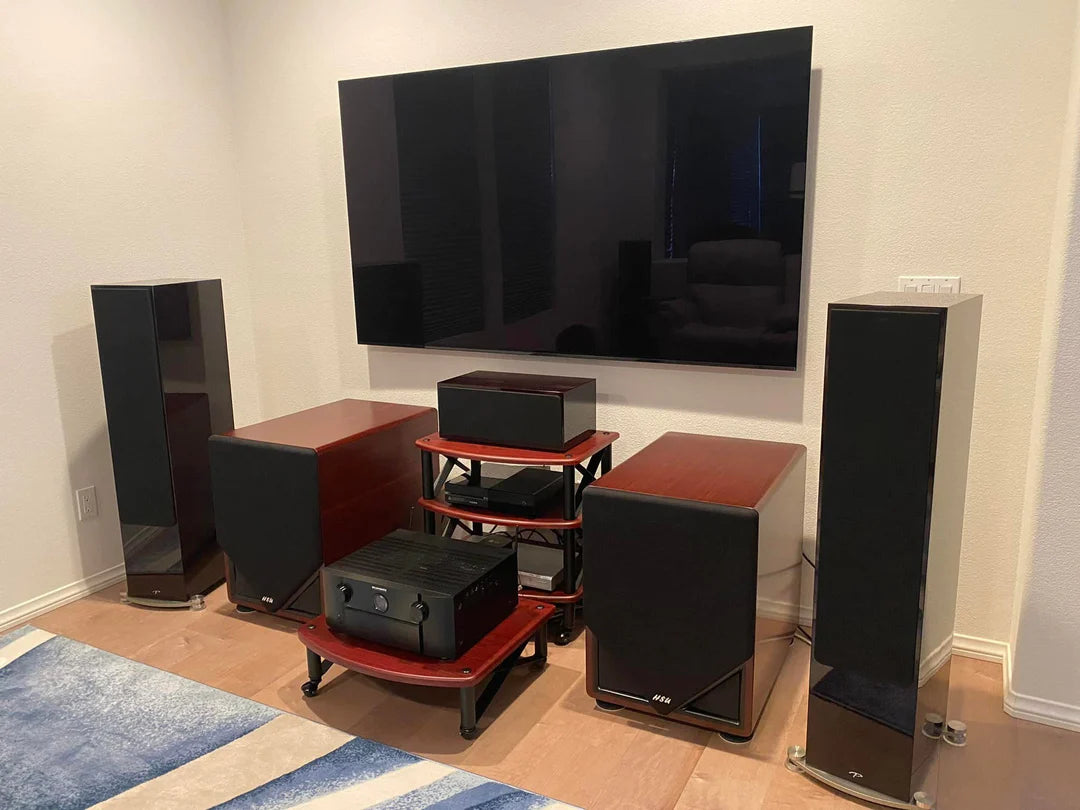Unless we’ve cracked the code to breaking the laws of physics, sound engineering is all about trade-offs. And the thing about finding the best system for your budget is that you’ll have to choose what’s most important to you. In this guide, we'll walk you through the questions Dr. Hsu uses, whether he’s designing a new sub or listening to a new system at a trade show.
Speakers: Unleash the Perfect Soundstage
-
How precise do you want your sound imaging to be? Do you want to be able to pinpoint individual sounds’ positions within a space? Or would you prefer a more immersive sound experience where the sound is all around you?
-
How stable do you want your sound imaging to be? Imagine moving around the room while enjoying your favorite movies or music. How important is it that your soundstage doesn’t collapse if you move away from the center seat? Do you want all your viewers to experience roughly the same quality of sound no matter where they’re sitting?
-
What kind of timbre speaks to you? Timbre refers to the tonal quality and characteristics of the sound. Do you prefer forward-sounding speakers that demand attention? Or do you prefer a more laid-back, airy sound that maintains its charm even at higher volumes? Does it bother you if the tonality changes when you stand up versus when you’re seated?
-
How loud do you like your music, game or movie? Do you like to listen at Dolby Reference level when watching movies or play your music like you will hear at a kive concert? Or do you prefer to listen at a level where you can still hold a conversation?
-
How much do you care about microdynamics and sound clarity? Microdynamics and clarity refers to the ability to distinguish the subtlest changes in tone or level. Do you want to hear the tiniest bounce of the bow on the strings, the subtle control of the damper pedal on the piano? Even discover sounds you may not have known were there before! Would you prioritize your speaker being able to portray the delicate shifts and fluctuations in sound level that give life and expressiveness to the music over how loudly it can play?
-
How much do you want your speaker to “disappear” in the soundstage? Picture a soundstage that feels like it's hanging in the air, with no physical awareness of the speakers. To some people, this gives you the sense that you are “sitting in front of the live concert” instead of listening through a stereo system. Others may not notice a difference.
-
Do your speakers need to win a beauty contest? How big does your space allow? Some people treat the speakers as part of the decor. It’s color, and shape must match the room and furniture, more so than the actual sound quality. Is this you or your spouse?
Now let’s dive into the world of subwoofers!
Subwoofers: Let’s Get Rumbling
-
How low do you want that bass to go? Chances are, if you’re in the market for a sub, you already know the answer to this. First, what do the frequencies mean to a listener? The lowest key on an organ is 16 Hz, the typical benchmark for the lowest frequency humans can feel. But not every subwoofer needs to go that low. For your typical action movie and video game, reaching as low as 25 Hz is usually good enough to give a foundation for powerful and rumbling sound effects.
-
How do you like to feel your bass? Good sound isn't just about hearing – it's about experiencing––it’s why Dr. Hsu started Hsu Research over 30 years ago. In the 16 to 20 Hz range, you’ll feel your couch shaking and the deep rumble in the room, like the air is vibrating. Only want that “punch in the chest” feel with explosions? That’s more like 40+ Hz.
-
How loud will you play your bass and how do you want your sub to behave when it hits its power limit? Now, this is a loaded question. Because bass frequencies, especially very low bass are extremely inefficient, subwoofers often hit their power limit. I’ll save the technical speak for later, but at the end of the day, if you are the listener who likes to crank up the volume, you will need to 1) decide what levels your sub has to reach while still maintaining low distortion and 2) decide what you’re willing to sacrifice once you’re past that limit.
-
How effortlessly do you want your bass to hit? Low distortion and wide dynamic range (‘high headroom’) gives you the effortless, airy bass. On the contrary, you may want to feel that extra oomph of hard-hitting bass.
-
Do you need your subwoofer to blend seamlessly? A sub that blends seamlessly will complement the main speakers, ensuring that it supports the overall audio reproduction without calling excessive attention to itself. On the other hand, you might want the bass to take center stage! The question to ask yourself is when there’s a thundering, explosive scene, how much attention do you want to draw to your subwoofer?
-
What flexibility do you have for placement and visibility? All subwoofers need good placement. Correct placement and seating location can make all the difference. How willing are you to optimize your room setup? What are your spouse and/or roommates okay with?
-
How big are you willing to go? For subwoofers, size matters. Just like you’ll need to sort out a 3 versus 5 seater couch before going to the furniture store, it’ll be helpful to know what your room has space for.
Armed with this newfound knowledge, you're now ready to embark on your journey to find the perfect combination of speakers and subwoofers that will bring your audio experiences to life.
Stay tuned for our upcoming blog posts, where we'll dive deeper into measuring speaker and subwoofer performance, helping you make even more informed choices.
So, go ahead and take the next step on your journey. Explore different brands, models, and specifications, and trust your instincts. Your dream home theater system awaits. Happy hunting, and may your experience be nothing short of extraordinary!
More notes and comments from Dr. Hsu about home theater systems
- What is your budget?
- Volume - how loud do you like the bass? Most often, the subwoofer will hit its power limit. How would you like the subwoofer to behave when it does that?
- What is your tradeoff between harmonic versus dynamic distortion?
- Option 1: strong limiter so distortion never gets high. But then instead of high harmonic distortion, you get high dynamic distortion (gets polite/dampened, no punch in the chest)
- Option 2: slightly less strong limiter so it allows some harmonic distortion and limit dynamic distortion.
- Distortion. Soft clipping to compress the sound once reach distortion limit.
- It’s common to run out of power for subs because you need 10x more power to sound twice as loud. So hitting the max for distortion limit is common.
- How does the subwoofer behave when you overdrive it?
- How low do you like the bass extension?
- Organ music / concerts - 16 Hz
- Average action movie - going down to 25 Hz is usually low enough. usually come mixed with mid/high-bass.
- Trade-off: would you rather have deeper bass extension versus higher headroom/being able to play louder?
- What do you like to feel for your bass?
- Couch shaking? - 16-20 Hz
- Punch in your chest? - 40+ Hz
- Musicality / Distortion?
- How effortless do you want the subwoofer to sound?
- How flexible are you about placement and visibility?
- All subwoofers need good placement. Make sure you understand your room setup, its needs, what your family/spouse are okay with. Check out future blog on placement :)
- How well will it fit in your space?
- For Subwoofers, size matters. The bigger the better.
- Figure out what your space has room for.


